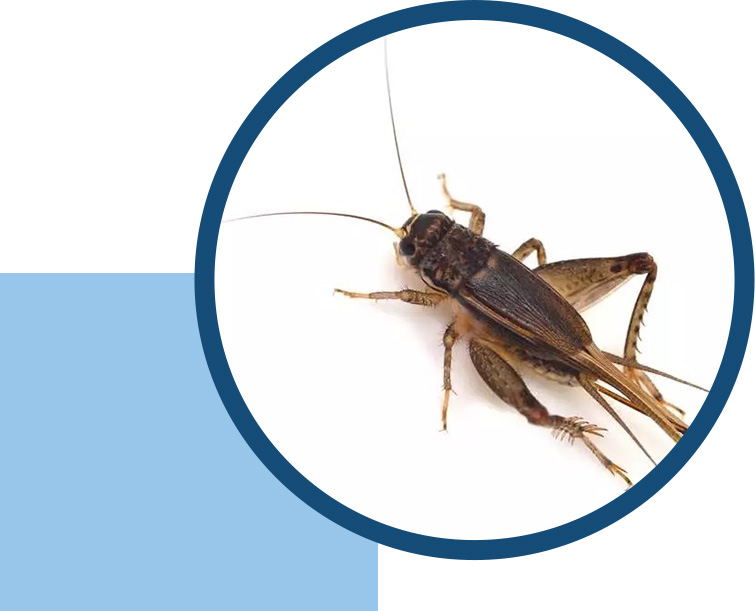
Crickets in Seattle, WA
Cricket Identification
Crickets are members of the order Orthoptera, which include grasshoppers and katydids. Crickets can be distinguished from grasshoppers by the way the wings are carried. The cricket carries its wings folded around the body, while the grasshopper carries its wings tent-like over the body. The sounds produced by crickets are made by the males rubbing their wings together to attract females. There are several hundred species of crickets found throughout the world, but the two most common to invade homes in the United States are the house cricket and field cricket.
House crickets are about 3/4” long with three dark bands on the head and long antennae. The body is light yellowish-brown and this cricket is most active at night, remaining hidden during the day. Field crickets are larger than house crickets and have wings that extend beyond their wing covers. Usually brown or blackish in color, field crickets frequently invade homes and are frequently found in pastures and meadows.


Hear from Our Pest-Free Customers
Proudly Servicing Seattle and Surrounding Areas in the Pacific Northwest
At United Pest Solutions, your satisfaction is our priority! See for yourself what our customers have to say about working with us.
-
"Clearly Knew How to Appropriately Address the Problem."Luke took a genuine interest in the situation, and clearly knew how to appropriately address the problem.- Bradley W.
-
"Thorough & Professional Check of Bait Boxes & Traps."Richard did a thorough and professional check of bait boxes and traps.- Julie H.
-
"Extremely Communicative, Professional & Respectful of the Property."United Pest Solutions was able to come the next morning after I contacted them.- Jenifer B.
-
"Very satisfied with the service and glad we are with United Pest Solutions."Tanner was great - communicative, friendly, & knowledgeable.- V Riles
-
"They offer excellent services."Rodents & bugs should be frightened! Their communication via text is great about arrival time.- Maureen H.
-
"He Was Very Professional & So Helpful."He was very professional and so helpful!!! Everyone on the phone was very good to work with as well!- Erin N.
-
"They are very professional!"They are very professional and thorough, and happy to address any concerns we may have.- Brian D.
-
"I have been super happy with my service."Garret was our last technician, and even though we have had repetitive treatments, he treated our house like it was our first visit.- Stephanie F.
Cricket Threats
Although they can bite, it is rare for a cricket’s mouthparts to puncture human skin. Crickets do carry a significant number of diseases, but do not transmit any fatal diseases to humans. The danger with crickets isn’t their bite; it is the parasites they can carry in their bodies and in their waste, like E. coli and salmonella.
It is usually after crickets have entered the home that most people really notice them and have complaints. The relentless nocturnal chirping produced by crickets can be especially bothersome to homeowners.
The house cricket and field cricket commonly invade homes in great numbers. When present in large numbers, crickets are a considerable annoyance and can cause damage to some fabrics such as silk, linens, rayon, and furs. They will attack paper, fruits, vegetables, and even rubber. They are omnivorous, eating and drinking almost anything available.
Cricket Extermination and Control
Unlike other home invaders, such as earwigs and boxelder bugs, which do not survive indoors, crickets do feed indoors and can live for longer periods of time than other nuisance pests. Follow these preventative pest control measures to keep crickets from entering your home.
- Make sure screen doors around your home are tight fitting and in good condition. Use weather stripping and door sweeps to keep crickets outside.
- Crickets commonly spend daylight hours hiding in dark, damp areas. Eliminate piles of wood, bricks, stone and other debris around the home to help reduce hiding spots.
- If crickets or their eggs are found indoors, use a vacuum to clean them up and dispose in trash.
- As crickets are attracted to light, consider changing outdoor lighting to less-attractive yellow bulbs or sodium vapor lamps.
- Place boric acid around the areas of your home where crickets congregate. Boric acid is a natural element that is generally safe for humans, but deadly to insects.
- Diatomaceous earth can be applied both indoors and outdoors and is safe if consumed by pets. Although it has no effect on humans or pets, this product works by scratching the exoskeleton of crickets, which leads to dehydration and death.







